The Magazine for Restaurant Professionals
May/June 1997
Pages 37-39
Fine Tuning
Despite having spent many years in the restaurant business, and most of them as a chef, the term “organic” in relation to a restaurant summons a connection with “health food”, which in turn conjures up associations like tasteless, brown, and chewy. It is a rare eating establishment that breaks with the traditional “if it tastes good it can’t be good for you” attitude. Most of us want, and expect, good food that’s good for us, too.
Lincoln Center is not the first venue that springs to mind for restaurants that take up this calling. Home to some of the top performances of ballet, opera and symphony orchestra, this is an enclave where tuxes per square yard measure in  the double digits. The cultural aficionados who gather here don’t want to sleep through performances. They want food that will wake them up and keep them going through three acts and two intermissions.
the double digits. The cultural aficionados who gather here don’t want to sleep through performances. They want food that will wake them up and keep them going through three acts and two intermissions.
The Restaurant
Across the street, Josephina has more than met the challenge. The term casual elegance was coined for this atmosphere. Bold, colorful murals of produce and street scenes from southern Italy splash across the walls. Tabletops, chair fabrics, and colorful woods make the room alive and vibrant. Josephina herself, grandmother of owner Louis Lanza, looms over the bar as an image in a mural. Location makes Josephina the perfect pre-performance dinner spot. With 175 seats, the staff handles 200-300 covers a night, twothirds of that between 5:00 and 8:00. This is a neighborhood that rolls up the sidewalks at the same time they hoist the curtains.
Food is focused on seafood and produce. Butter and cream are rarely used in cooking here. Spicing is important, and the chef has a generous hand with them. Each part of the dish is carefully cooked and seasoned on its own, so even thos of us who tend to pick apart dishes don’t miss out on the spirited flavors.
The Wine Program
All of this has made for an unusual wine program. Because most diners are off to a three or more hour performance, they don’t drink heavily. Wine by the glass outsells wine by the bottle by astronomical proportions. While three to four cases of wine are typically sold each evening, less than one of those is sent to the table in bottle.
Edward Ting, along with managing the restaurant’s general operations, has been charged with upgrading the wine list. Prior to his arrival, the list was not a priority for management. Customers were happy just having “a glass of wine,” and the dozen item selection reflected that reality. But with the opening of his new fine-dining restaurant, Ansonia, owner Lanza saw the opportunity to simultaneously upgrade the quality at Josephina.
Over the last year, Ting has eliminated off-vintage specials, poor producers and a dependence on California Chardonnay and Cabernet. The list now features forty wines; other grape varietals, quality producers and a small but growing selection of entries from the rest of the world have been introduced. Staff training and tasting sessions have become part of the daily regimen. With the focus on glass sales, a range of styles are now offered, currently six whites, six reds, and two sparkling wines. A beer list was added, with attention to a variety of styles.
Wine pricing here is somewhat erratic and probably is a reason for the low sales volume. The official pricing plan is 2.75 times cost, but in truth, wines are priced from two to nearly seven times cost. By-the-glass prices are a little high at a bit more than one-quarter the cost of a bottle for a small, four-to-five ounce pour.
Much of what sells does so on name recognition: Sonoma-Cutrer, Mondavi, Hess and Gloria Ferrer. But the two biggest movers, Bonterra Chardonnay and Jenard Merlot, easily outsell the other wines. They fly into the glasses for what would seem to be an obvious reason: they’re both marked on the list as “organic.” Not only do customers pick them on their own, but for the waitstaff, it’s a readily available “hook” when it comes to making a recommendation.
An Adjustment, Not an Overhaul
Everone knows the old adage, “if it ain’t broke, don’t fix it.” For the most part, Josephina’s wine list works: customers seem to be happy with the general approach to wine, as evidenced by gradually increasing sales, and the staff is excited about the offerings. What’s needed her is some fine tuning.
 Presentation is everything in sales, and a good product with a good presentation is golden. Josephina’s wine list is presented simply in a plain, clear plastic cover with a dark red border. The beer list is on the front, and the wine list comprises the inside two pages. The cover itself is fine, being simple and non-threatening. ON the other hand, the list is printed on white copier paper and contains several minor spelling, accenting, and formatting errors. Even for casual elegance, this is too casual.
Presentation is everything in sales, and a good product with a good presentation is golden. Josephina’s wine list is presented simply in a plain, clear plastic cover with a dark red border. The beer list is on the front, and the wine list comprises the inside two pages. The cover itself is fine, being simple and non-threatening. ON the other hand, the list is printed on white copier paper and contains several minor spelling, accenting, and formatting errors. Even for casual elegance, this is too casual.
It would be worthwhile for the restaurant to invest in a better grade of paper, something reflective of the environment in which the list is presented. Around the colorful murals, tabletops and fabrics, the walls of osephina are designed with a simple, dark cream colored faux marble. This is a readily available paper style and is more reflective of the class of the restaurant, and this simple change would enhance the overall experience. The layout of the list is easy to follow and read. Sticking with the overall format, but switching to a more interesting and elegant font, will contribute to the quality feel of the list.
Who among us hasn’t shared and laughed over some error in translation or description that lef a dish or wine sounding more humorous than ingestible? Simple mistakes in wine names may be noticed only by those of us in the business, but, hey, we’re customers too. Attention to correct spelling and accenting are easy fixes. More important here is the inconsistency in listing of wines. Some are listed with producer first, some with varietal or name and some with region of origin. Again, a simple tune-up will cure this problem.
As noted earlier, one of the selling points for wines here is the tag “organic.” There are numerous organic wines on the market, many of them of excellent quality. It doesn’t pay, however, to dump everything else that works in pursuit of such a focused idea – too much of a good thing and all that. A sound approach would be to showcase a few wine selections that are noted as quality organic wines.
Although Ting would like to expand the list to around fifty selections and to offer a more worldwide representation, his storage space is limited.Given its by-the-glass success, Josephina needs na expansion of that program, not an increase of the overall list. All wines should be available on a by-the-glass basis.
The Josephina list also includes a few higher end items. Simply, these don’t sell. They have not been offered by the glass, because waste would be too costly. Although they are a minimal investment for Ting (they are supplied in small quantities of two or three bottles at a time by the owner’s other restaurant, Ansonia), they take up unnecessary space on the list and contribute to a feeling that the list is a bit higher priced than it ought to be. Paring these to a minimum is a priority and offering what remains by the glass will yield a sales alternative that will attract attention from customers. A worthwhile investment might be a small, home style gas-preservation system for these few, more expensive wines.
Pricing Recommendations
Pricing is the last, but by no means the least, important issue. The primary problem is one of consistency. Two wines that cost the restaurant the same amount ought to be priced on the list at the same amount. A simple example – Fortant de France White Merlot costs $4.67 and is offered at $18.50 while Columbia Cresta Merlot costs $4.50 and is priced at $26.00. It is always difficult to come up with a fair pricing scheme; some opt for flat increases, others for certain percentages in ranges of costs (e.g., 2.5 times if it costs $5-10, 3 times if less, 2 times if more). I generally recommend a sliding scale, in this case two times costs plus $8. This keeps the higher end wines right around the twice cost markup, and the lower end wines generally end up in the 3-4 times range.
By-the-glass pricing in New York is typically one-quarter of bottle price, but pours are more often around six ounces than the four-to-five that Josephina offers. With its significant investment in smaller sized glassware, the restaurant should consider lowering their prices on glass sales. Owners are rightly entitled to a profit, and in this case, the customers don’t seem to object. This is a decision that Josephina’s management will have to consider over time.
All-in-all, Josephina has a winning structure here. Fine tuning provides a way to increase customer and staff enthusiasm, build profits, and generally make the whole dining experience more enticing. After all, that’s why we’re all in this business.

Santé is a glossy format trade magazine for restaurant wine buyers and educators. I wrote as a freelancer for them on and off from the first issue in November 1996 until November 2002 when they decided to stop using freelance writers.
